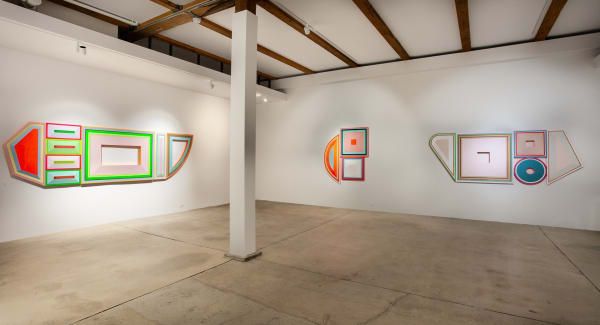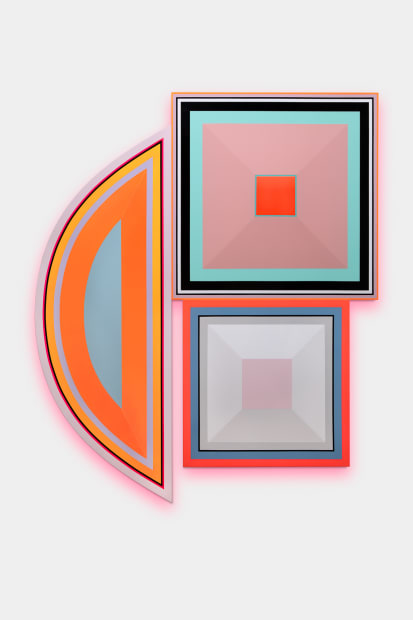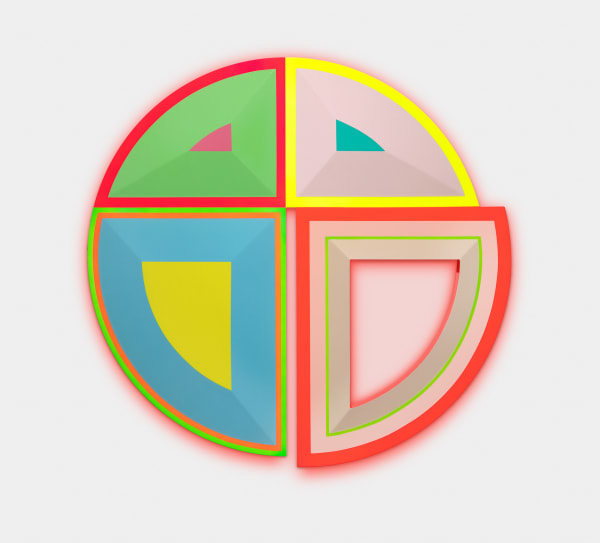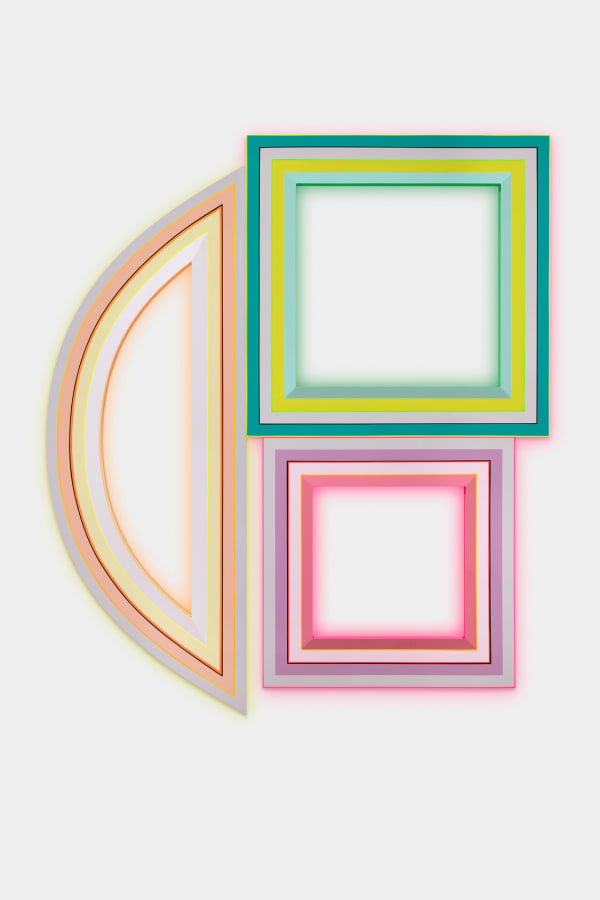-
Kavi Gupta proudly presents FEELS LIKE LOVE, a solo exhibition of new paintings by Beverly Fishman, acclaimed visual artist and Anonymous Was A Woman Award Winner, John Simon Guggenheim Memorial Foundation Fellow, and National Endowment for the Arts Grantee.
A single heart punctuates the eight-foot-long multi-form that serves as the central painting in FEELS LIKE LOVE. The middle of the heart has been carved out, its reflective, pink inner wall subtly illuminating the void. Seduced by such an elegant and innocent form, will viewers recognize the heart’s true origin as the commercial logo for the world’s most successful brand of Diazepam?
“The heart is an abstraction of the V in Valium,” Fishman says. “It’s sinister. Hopefully people get that there’s that dark side. But nothing is reduced in my thinking to right or wrong, or yes or no. It’s a more complex situation, and I’m trying to negotiate that.”
Fishman’s luminescent, geometric relief paintings beguile the eyes. Along with their radiant material presence, their uncanny structures challenge viewers to look beyond the surface, to try to recall where it was that they have seen these curious shapes before. Epiphany is aided by the titles Fishman gives her paintings, which invoke a litany of ills, such as depression, high blood pressure, bipolar disorder, opioid addiction, insomnia, and ADHD—these are pharmaceutical forms, abstracted from the pills we ingest every day to balance our bodies and minds.
For decades, Fishman has diligently studied the visual vocabulary that pharmaceutical designers deploy in their calculated efforts to market antidepressants, anxiolytics, amphetamines, anti-inflammatories, beta blockers, opioids, and other chemicals to the masses. Morphed and elevated by Fishman in her studio, these medicinal motifs become the building blocks for ecstatic visual cocktails that open doors to the aesthetic sublime.
-
Beverly Fishman, FEELS LIKE LOVE, Virtual Walkthrough
-

-
Another large-scale multi-form in FEELS LIKE LOVE, a companion piece to the heart relief, includes two stacked and conjoined circles, one open and one closed; the closed circle is fluorescent red like a stop sign.
“The circles are abstract, but painting one red made it more like signage to me, like stop,” Fishman says. “Then there are the missing pieces, or the multiple pieces that represent the different pills that a single person takes every day—medicine has done this by fracturing us through its specialties. We become divided. We disassociate ourselves from our body. We’re not comfortable in our skin.”
FEELS LIKE LOVE arrives at a crucial moment in America’s relationship with healing, when people are less connected than ever, and antidepressant use and opioid dependency are at historically high levels.
“With the pandemic there are more suicides, more domestic abuse, more of everything on the dark side. Of course, a chemical that will make you feel love right now would be the most overused thing in the world,” Fishman says. “Who doesn’t want to feel love?”
Formal conceptual concerns related to movements such as Minimalism and Light and Space also guide Fishman’s practice, as does intuition. Among her most masterful aesthetic faculties is Fishman’s ability to create specialized, highly emotive color worlds for her exhibitions.
-
“I think about the totality of the experience of the color,” Fishman says. “Color is mysterious to me.”
- BEVERLY FISHMAN
The color world of FEELS LIKE LOVE is opalescent and electric, enmeshing the mind in a flocculent, cotton-candy-like state of comfort. The highly reflective automotive paint, Fishman’s medium of choice, gives her paintings such highly polished surfaces that they seem to glow. That iridescent light radiates into the empty spaces in the forms, creating transcendent zones that speak both literally and metaphorically to the potential of voids.
“I never want my work to be literal, or easily reduced down to something more singular,” Fishman says.
Nonetheless, like all important achievements in symbolism, Fishman’s pill reliefs transmit lasting truths about the human condition to those literate and brave enough to read between the shapes.
One in five Americans today lives with chronic pain. One in seven lives with some kind of anxiety disorder. The human brain manufactures its own chemical remedies that comfort us, and heighten our feelings of connection to others. When our chemicals are imbalanced, companionship, conversation, and professional therapy can help.
Pharmaceuticals should be a last resort. Nonetheless, since their introduction in the 1960s, Valium and other forms of Diazepam are the most widely prescribed, and widely abused drugs in the world, along with opioids, antidepressants, and antipsychotics like Abilify. And just like the tranquilizers and lobotomies that preceded them, these drugs are overwhelmingly prescribed to women.
-

-
“Pharmaceuticals intersect with feminism,” Fishman says. “Women were given Valium for their nerves. Why were they nervous? Were they unsatisfied with their lives, with their options? They were anesthetizing an entire generation.”
Fishman’s phosphorescent blasts of geometric lucidity illuminate the shadowy battleground on which we fight against an unchecked Pharmaceutical Industrial Complex, to assert the right to understand and define our own bodies and identities.
Fishman says. “I’m in the unknown. Can abstraction be political and socially relevant? These are things I’ve always thought were important in my work. What drives me is all the stuff I speak about, the medical stuff, the pain. I have a few single friends that almost lost their minds during this pandemic, they were so isolated from everyone. It’s real. The pandemic has caused a lot more distress. So if it feels like love, baby, let’s go for it.”
-

Beverly Fishman
Untitled (Depression, 4@Asthma, Osteoporosis, Anxiety, Depression), 2022Urethane paint on wood
48 x 162 x 2 in
121.9 x 411.5 x 5.1 cm -

Beverly Fishman
Untitled (Epilepsy, Depression, Opioid Addiction, Pain, Anxiety), 2022Urethane paint on wood
48 x 120 x 2 in
121.9 x 304.8 x 5.1 cm -
 Beverly Fishman, FEELS LIKE LOVE, (Installation view)
Beverly Fishman, FEELS LIKE LOVE, (Installation view) -
-
-
 Beverly FishmanUntitled (Diabetes, Opioid Addiction, Pain, Osteoporosis, Depression), 2021Urethane paint on wood46 x 88.8 x 2 in
Beverly FishmanUntitled (Diabetes, Opioid Addiction, Pain, Osteoporosis, Depression), 2021Urethane paint on wood46 x 88.8 x 2 in
116.8 x 225.4 x 5.1 cm -
 Beverly FishmanUntitled (Insomnia, Opioid Addiction, Pain), 2022Urethane paint on wood38 x 38 x 2 in
Beverly FishmanUntitled (Insomnia, Opioid Addiction, Pain), 2022Urethane paint on wood38 x 38 x 2 in
96.5 x 96.5 x 5.1 cm -
 Beverly FishmanUntitled (Epilepsy, Depression, Opioid Addiction, Pain, Anxiety), 2022Urethane paint on wood48 x 120 x 2 in
Beverly FishmanUntitled (Epilepsy, Depression, Opioid Addiction, Pain, Anxiety), 2022Urethane paint on wood48 x 120 x 2 in
121.9 x 304.8 x 5.1 cm -
 Beverly FishmanUntitled (Pain, Opioid Addiction, Opioid Addiction), 2022Urethane paint on wood64 x 55.5 x 2 in
Beverly FishmanUntitled (Pain, Opioid Addiction, Opioid Addiction), 2022Urethane paint on wood64 x 55.5 x 2 in
162.6 x 141 x 5.1 cm -
 Beverly FishmanUntitled (Diabetes, Pain, Pain, Chronic Pain, Pain), 2022Urethane paint on wood48 x 92 x 2 in
Beverly FishmanUntitled (Diabetes, Pain, Pain, Chronic Pain, Pain), 2022Urethane paint on wood48 x 92 x 2 in
121.9 x 233.7 x 5.1 cm -
 Beverly FishmanUntitled (Depression, Missing Dose), 2022Urethane paint on wood39 x 40.4 x 2 in
Beverly FishmanUntitled (Depression, Missing Dose), 2022Urethane paint on wood39 x 40.4 x 2 in
99.1 x 102.5 x 5.1 cm -
 Beverly FishmanUntitled (Pain, Pain, Anxiety, Pain, GERD), 2022Urethane paint on wood48 x 96 x 2 in
Beverly FishmanUntitled (Pain, Pain, Anxiety, Pain, GERD), 2022Urethane paint on wood48 x 96 x 2 in
121.9 x 243.8 x 5.1 cm -
 Beverly FishmanUntitled (Pain, Two Missing Doses, Opioid Addiction), 2022Urethane paint on wood75.5 x 65.4 x 2 in
Beverly FishmanUntitled (Pain, Two Missing Doses, Opioid Addiction), 2022Urethane paint on wood75.5 x 65.4 x 2 in
191.8 x 166.1 x 5.1 cm -
 Beverly FishmanUntitled (Pain, Opioid Addiction, Depression), 2022Urethane paint on wood45 x 40 x 2 in
Beverly FishmanUntitled (Pain, Opioid Addiction, Depression), 2022Urethane paint on wood45 x 40 x 2 in
114.3 x 101.6 x 5.1 cm -
 Beverly FishmanUntitled (Depression, 4@Asthma, Osteoporosis, Anxiety, Depression), 2022Urethane paint on wood48 x 162 x 2 in
Beverly FishmanUntitled (Depression, 4@Asthma, Osteoporosis, Anxiety, Depression), 2022Urethane paint on wood48 x 162 x 2 in
121.9 x 411.5 x 5.1 cm
-


















